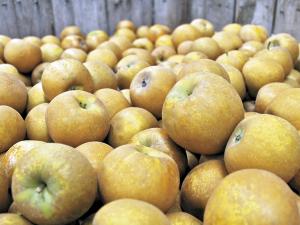Roxbury Russets great to eat or make into cider
Apples grown from seed almost always grow entirely differently than their parents. While this could be a curse, for colonial Americans this was the apple’s blessing. Many of the original varieties of apples simply didn’t do well in America’s harsher climate. But plant thousands of apple seeds and at least some of them are bound to grow into something worthwhile.
One seedling apple tree sprouted around 1635 in the town of Roxbury, now part of Boston. Like many good keeping apples, this grey-green apple had a scaly skin, known as russeting, and being from Roxbury became America’s first named apple, the Roxbury Russet.
This excellent old cider apple can keep fresh for months and still be good to eat out of hand. It has an extremely high sugar content of around 12.87 percent sugar, which is higher than even most sweet cantaloupes or watermelons. That sugar ferments to 6 percent alcohol when made into hard cider.
Like many russet apples, the Roxbury has a flavor that some describe as nutty. The fruits are quiet large and ripen in mid to late fall, late September to October in most areas. The russeting can vary from patches to just about covering the entire apple, and often the fruits are attractively blushed red. How much russeting is on apples can be affected by things such as the weather, or even disease or pest damage. Other names for russet apples include “rusticoat” and “leathercoat.”
Shakespeare refers to russet apples in his play “Henry IV” when Davy says to Bardolph, “There’s a dish of leathercoats for you.”
The Roxbury Russet is resistant to common apple diseases such as scab, fireblight and cedar apple rust. Thomas Jefferson planted quite a few Roxbury Russet apple trees in his South Orchard at Monticello.
Besides being a great cider and juice apple, Roxbury Russets are good to eat out of hand or sliced into salads and cooked into applesauce.
Sadly, because modern shoppers eat with their eyes, the brownish Roxbury Russet is no longer widely grown and is hard to find.
You can order trees from specialty nurseries such as Trees of Antiquity, 20 Wellsona Road, Paso Robles, CA 93446; phone: 805-467-9909; or Seeds of Change at www.Seedsofchange.com.
They are hardy in USDA zones 5-9. Choose a planting site that gets lots of sun and has good drainage. If your tree is bare root, soak the root ball in a bucket of water for about an hour before planting. This will let the tree absorb water. Dig a hole at least twice the size of the root ball.
Set the tree in and backfill with soil. Ideally your soil should have a pH near 6.5. Water well to get rid of any air pockets.
Over 15,000 new American varieties were named before 1900, and sadly, many have been lost forever. You can help preserve our heritage by choosing antique or heritage trees for your yard and orchard.
Plant a Roxbury Russet tree and you will have a piece of history that you can eat, or better yet, drink.


















































